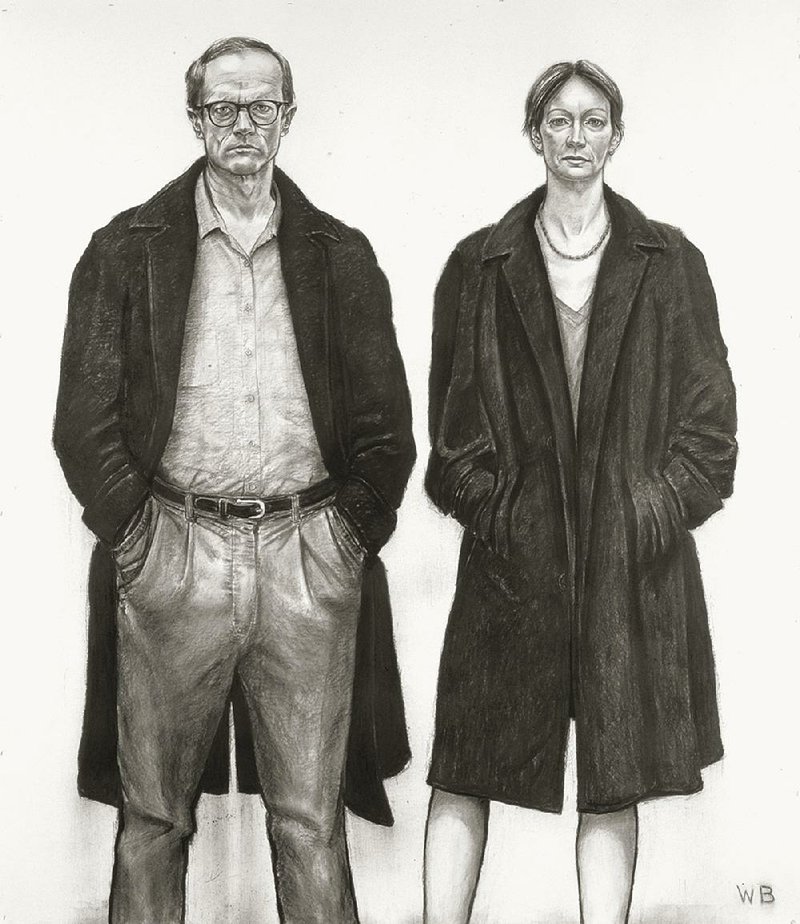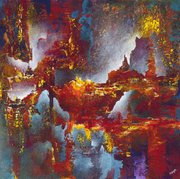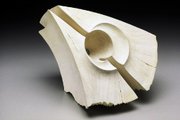The drawings of William Beckman arouse and lay bare an emotional landscape that will be very familiar to anyone who appreciates the intelligence and depth of songs written by Leonard Cohen, Joni Mitchell and Merle Haggard.
Like the music of those songwriters, Beckman's work is boldly drawn and aches with longing, strips emotional artifice to the bone with heartbreaking reality and can be infused with a sometimes bleak, bittersweet resignation. Yet, when hope might be only barely in sight, the search for meaning and love continues.
"William Beckman: Drawings, 1967-2013," at the Arkansas Arts Center through Feb. 1, focuses on the photorealist painter's powerful charcoal and graphite drawings. Beckman's figure drawings are especially acclaimed, and rightfully so.
A series of large works in one gallery, mostly nudes, are particularly revealing of a couple's naked, conflicted and raw emotions.
As Beckman says in a quotation written on the exhibition wall: "Nothing has touched my soul like the figure."
The viewer feels that instinctively; that statement takes on an added significance given that the artist and his former wife are the models for a number of these pieces. The longer one stays in their company, the more we feel them -- or perhaps a situation of our own.
In several of these images, the man is partially clad, while the woman is mostly nude. Perhaps that reflects the idea that women are more open, less afraid of being exposed emotionally than men (or this particular man?).
Study for Red Painting (man-woman 3), like most of Beckman's work, commands the eye and engages the viewer. The figures have a strong charcoal outline; the wonderfully drawn faces are a fascinating study in tension and feelings that seem to verge on primal.
The couple may be standing closely, but there is no closeness. They may be struggling for a connection ... or a way to get farther apart. The woman's arched eyebrow in Man-Woman 2 suggests any number of possibilities.
The drawings from Beckman's "Classical Woman" series fascinate, suggesting a Titian-like beauty and, particularly in Classical Woman 3, Edgar Degas.
Beckman's portraits in the next room come almost as a relief after the intensity of the previous gallery. They are warmer, more inviting. It is here we see some fascinating faces, each revealing and reflecting the gamut of emotion and character.
Several large-scale drawings from "Bull Series" are powerful and threatening; a line of bulls charging toward the viewer makes it clear they have no intention of stopping and we'd better get out of the way.
But before you leave the exhibit, be sure to take another look at the magnetic Self Portrait in Studio, a 1984 charcoal of a strong, confident Beckman at the entrance to the exhibit. Also, don't miss Tarzan -- Comic-book Cover, which he says was drawn in church when he was around 8 or 9 years old. "My brother and I drew while in church. Kept us quiet," he says.
Also at the Arts Center is a fine show of sculpture by Stoney Lamar, who works mostly with wood and steel. His sense of line and form have a remarkable grace. Lamar is well known for his experimental approach in design and use of the wood lathe, materials and tools.
Those who have seen the work of Little Rock artist Robyn Horn should have an idea of what to expect.
And Lamar does not disappoint.
High points include Indian Altar, an exquisite maple burl sculpture with a gorgeous grain and finish exceeded only by its stunning lines and form; Suspended Wire Walker, a cocobolo sculpture that mimics that delicate balance the title suggests; and the dream tunnel-like construction that is Arches, an ash and steel sculpture.
Tower, about 7 feet tall, is a totemic white oak and steel creation. It draws the viewer's imagination in an almost Jungian way to suggest any number of spirits and animals.
"William Beckman: Drawings, 1967-2013," through Feb. 1; "The Sculpture of Stoney Lamar," through Jan. 18, Arkansas Arts Center, MacArthur Park, East Ninth and Commerce streets, Little Rock. Hours: 10 a.m.-5 p.m. Tuesday-Saturday, 11 a.m.-5 p.m. Sunday. Info: arkansasartscenter.org or (501) 372-4000.
BRIEFLY ...
• New works by Little Rock oil painter Sheila Cotton are hanging at Fayetteville Underground. "The Lay of the Land" is part of a continuing series of works by Cotton that pay tribute to the South, especially its varied landscapes such as cotton fields, swamps, gardens and more.
Cotton's style, magical realism, infuses her canvases with a sense of mystery and psychological drama.
"The Lay of the Land," through Nov. 30, Fayetteville Underground, 101 W. Mountain St., Suite 222, Fayetteville. Hours: 10 a.m.-7 p.m. Wednesday-Saturday, noon-5 p.m. Sunday. Info: (479) 871-2722, fayettevilleunderground.com.
• "The Movement of Line," featuring new works by painters Elizabeth Weber and Robin Hazard-Bishop and sculptor Andy Huss, which opened Saturday, runs through Nov. 29 at Boswell Mourot Fine Art, 5815 Kavanaugh Blvd., Little Rock. Hours: 11 a.m.-6 p.m. Monday-Friday, 11 a.m.-3 p.m. Saturday. Info: (501) 664-0030 or boswellmourot.com.
• Gallery II in the Fine Arts Building at the University of Arkansas at Little Rock, has been renamed the Ann Maners and Alex Pappas Gallery. The doctors have been supporters of the arts at UALR for more than two decades, says Brad Cushman, director of the UALR galleries.
The couple established an endowment for the gallery program and to support guest artists and lecturers. They also created the Pappas Study Abroad Endowment, which provides UALR art students travel opportunities.
Pappas is a former professor in the Department of Pathology at the University of Arkansas for Medical Sciences. Since 1985, Maners has practiced as a radiation oncologist for the Central Arkansas Radiation Therapy Institute (CARTI).
Email:
ewidner@arkansasonline.com
Style on 11/09/2014


